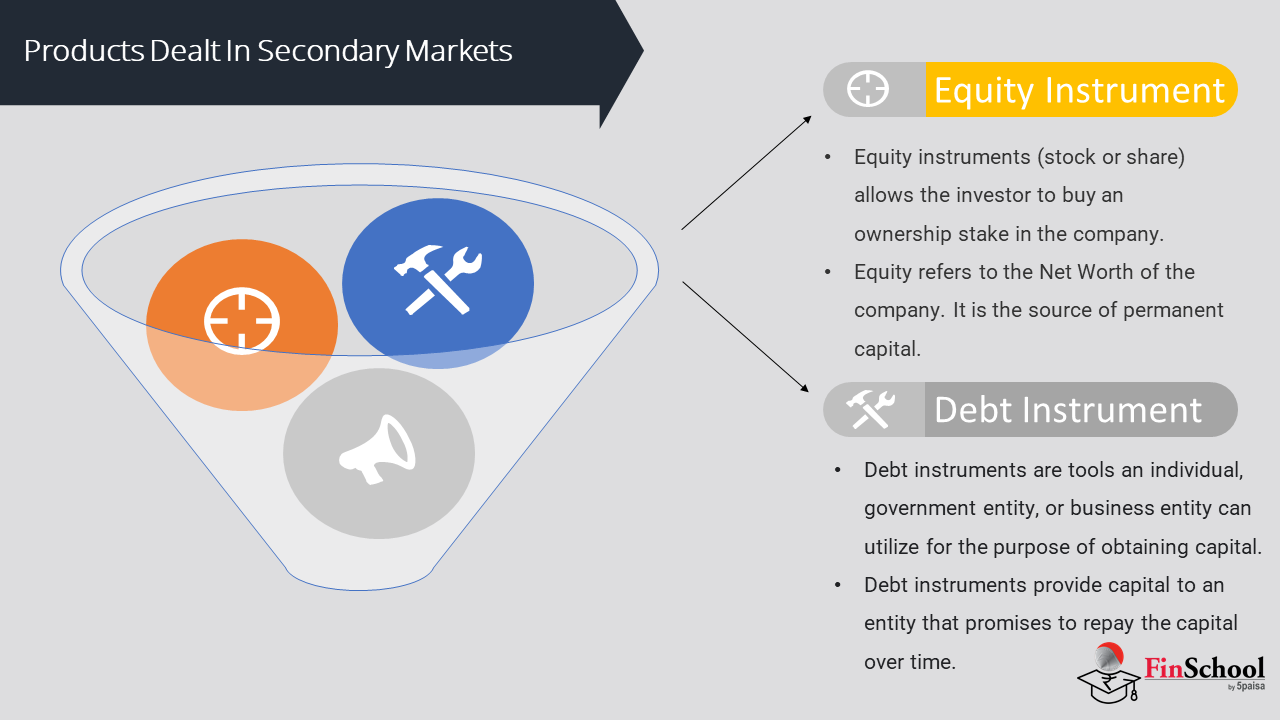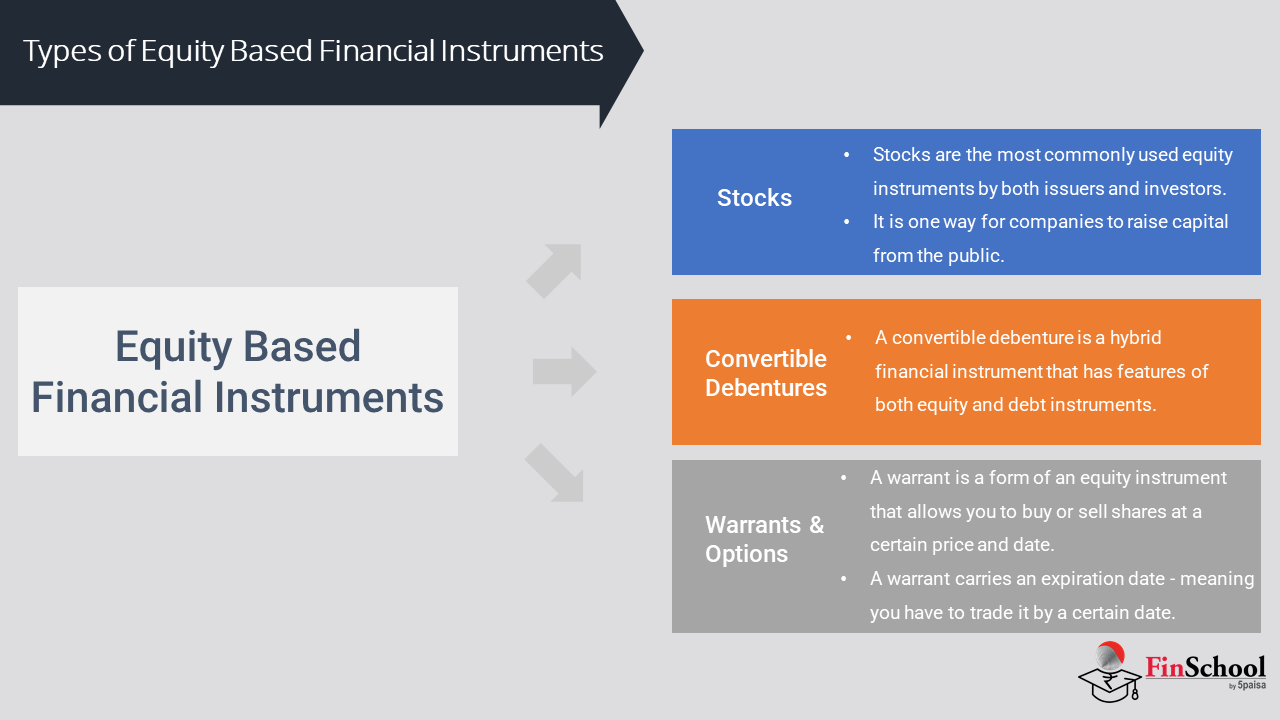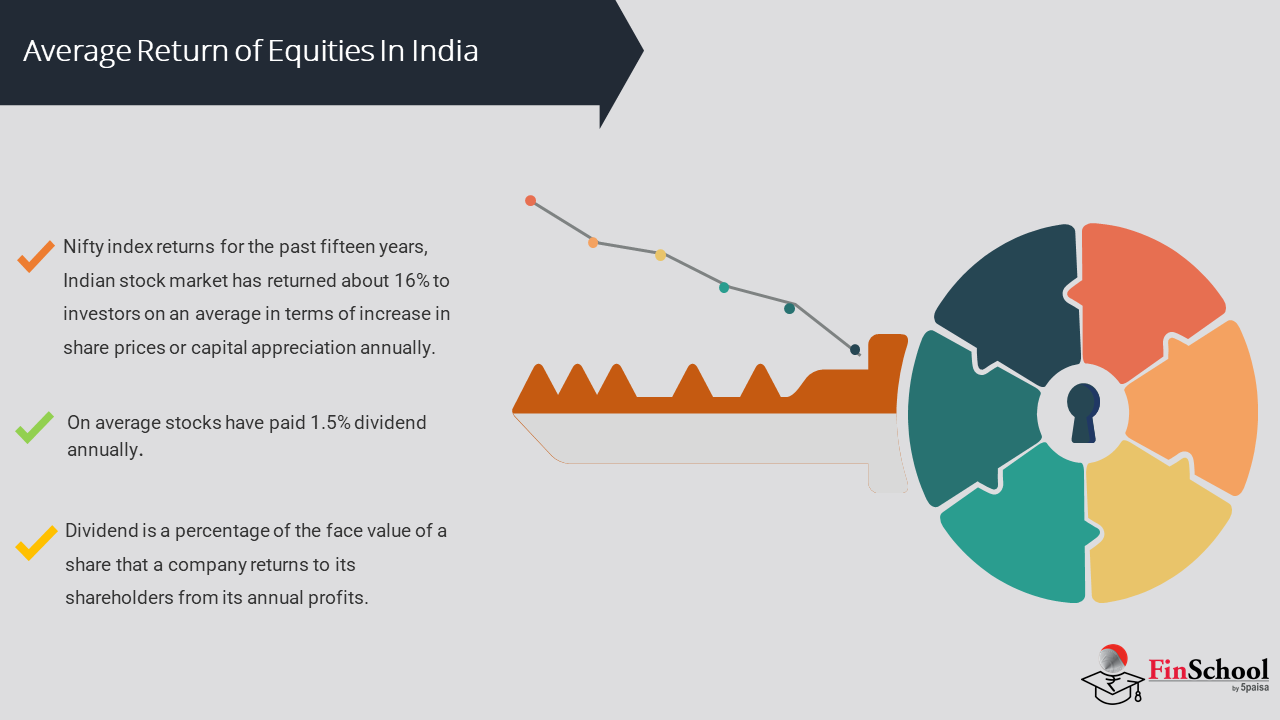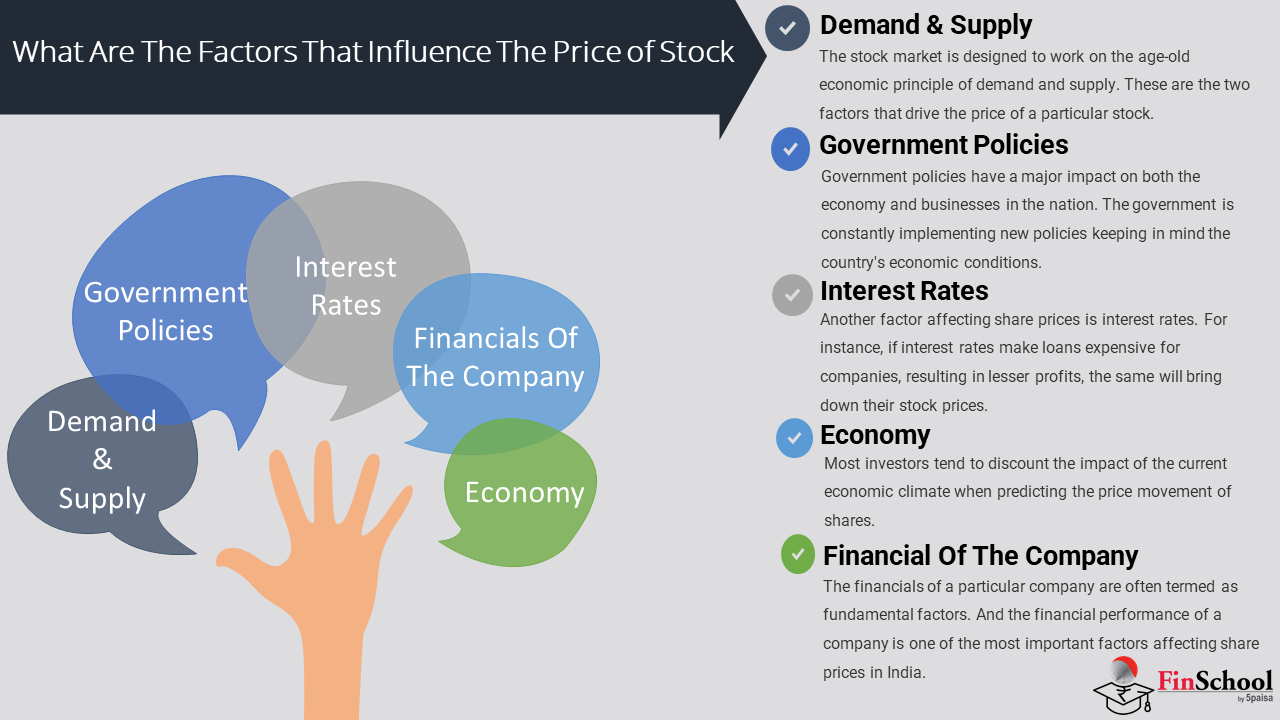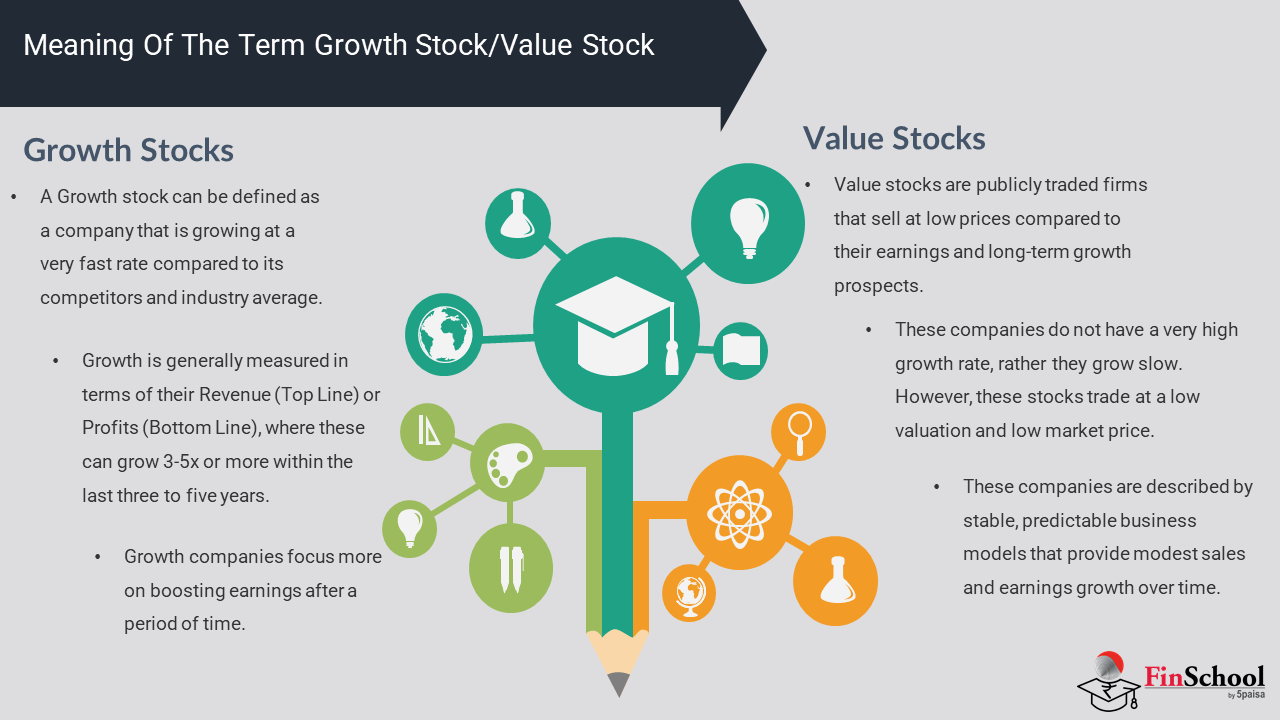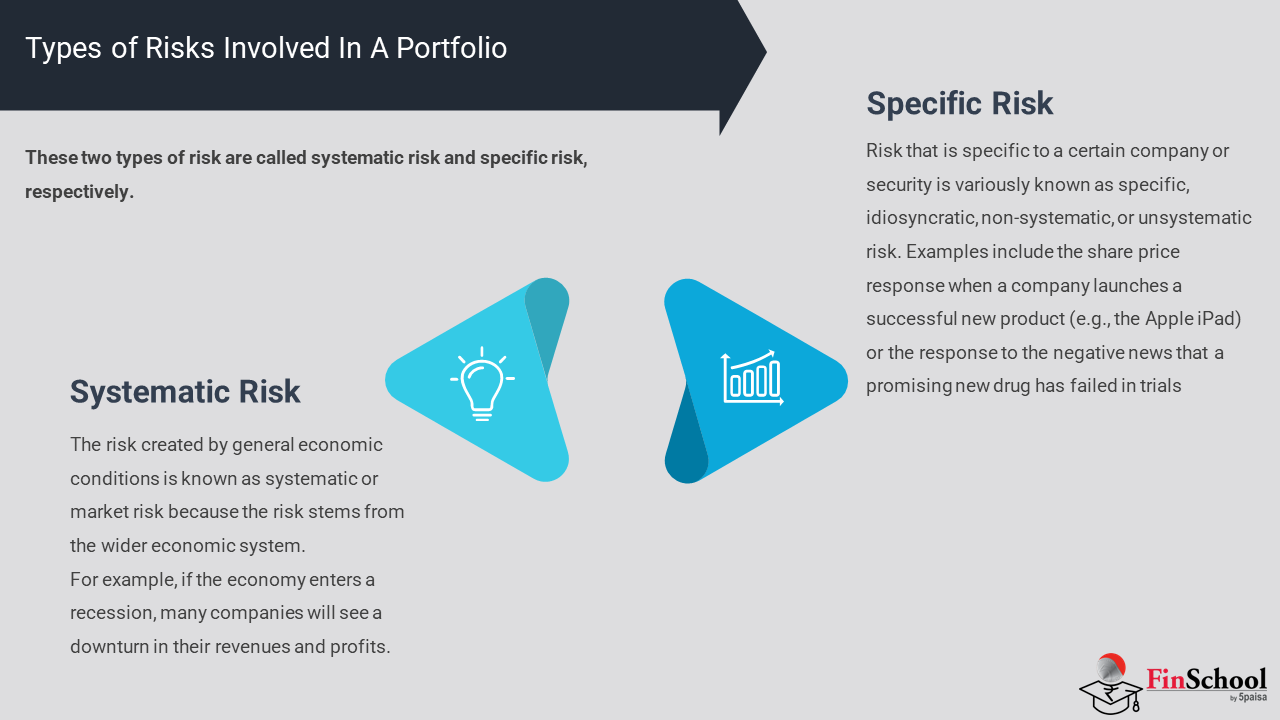- Study
- Slides
- Videos
6.1 What Are The Products Dealt In Secondary Markets?
The following are the products dealt in secondary market: –
- Equity Instrument
- Debt Instrument
Equity Instruments
Equity instruments (stock or share) allows the investor to buy an ownership stake in the company. Equity refers to the Net Worth of the company. It is the source of permanent capital. Equity instruments may or may not pay their investors a monthly income because such income relies on the profit/loss of the business. When they do, it is a dividend.
The most common types of equity-based financial instruments are:
- Stocks
Stocks are the most commonly used equity instruments by both issuers and investors. It is one way for companies to raise capital from the public.
There are two types of stocks:
-
- Common or ordinary stocks
- Preferred stocks
Investing in common/ordinary stocks comes with various benefits, such as:
-
- Co-ownership of the company
- Right to vote in shareholders’ meetings
- Right to make decisions on capital raising, dividends, and business mergers
- Authority to apply for new shares when the company’s capital increase
- Can declare common stocks as assets when applying for loans
Common/ordinary stocks, however, do not guarantee dividends, nor are they the priority when the company makes any profits. Common stockholders also undertake a massive amount of business risk should the company face a loss. Of course, when the company makes a profit, they do receive a higher dividend. However, they are paid in the end – after paying creditors and other priority shareholders.
Preferred stockholders also have ownership of the business with an extra priority in paying dividends. They will be the second to receive payment after bondholders. They will receive payments regardless if the company is liquidated, and their dividends will increase if the company makes a profit. However, they do not have any voting rights like common stockholders. Hence they do not have to carry many risks like ordinary shareholders.
- Convertible Debentures
A convertible debenture is a hybrid financial instrument that has features of both equity and debt instruments. It is similar to a common bond, but an investor can convert it into common stock after a period of a specified time. It is a popular form of equity instrument investment because the interest rates are higher than bonds.
Convertible debentures are usually unsecured bonds that may not have collateral as a backup. The conversion to common stocks hedges against that risk by allowing the investor to become a co-owner.
- Warrants And Options
A warrant is a form of an equity instrument that allows you to buy or sell shares at a certain price and date. A warrant carries an expiration date – meaning you have to trade it by a certain date. The company itself issues it. Options, likewise, are also an equity instrument but offered on the stock exchange. Options also allow you to trade in the stock exchange at a certain price and date but investors can refuse to trade within the period.
Features That Characterize And Vary Among Equity Securities:
- Life
Many equity securities are issued with an infinite life. In other words, they are issued without maturity dates. Some equity securities are issued with a maturity date.
- Par Value
Equity securities may or may not be issued with a par value. The par value of a share is the stated value, or face value, of the equity security. In some jurisdictions, issuing companies are required to assign a par value when issuing shares.
- Voting Rights
Some shares give their holders the right to vote on certain matters. Shareholders do not typically participate in the day-to-day business decisions of large companies. Instead, shareholders with voting rights collectively elect a group of people, called the board of directors, whose job it is to monitor the company’s business activities on behalf of its shareholders. The board of directors is responsible for appointing the company’s senior management (e.g., chief executive officer and chief operating officer), who manage the company’s day-to-day business operations. But decisions of high importance, such as the decision to acquire another company, usually require the approval of shareholders with voting rights.
- Cash flow rights Life
Cash flow rights are the rights of shareholders to distributions, such as dividends, made by the company. In the event of the company being liquidated, assets are distributed following a priority of claims, or seniority ranking. This priority of claims can affect the amount that an investor will receive upon liquidation.
6.2 Why Should One Invest In Equities In Particular?
When you buy a share of a company you become a shareholder in that company. Shares are also known as Equities. Equities have the potential to increase in value over time. Research studies have proved that the equity returns have outperformed the returns of most other forms of investments in the long term. Investors buy equity shares or equity based mutual funds because: –
- Equities are considered the most rewarding, when compared to other investment options if held over a long duration.
- Research studies have proved that investments in some shares with a longer tenure of investment have yielded far superior returns than any other investment. The average annual return of the stock market over the period of last fifteen years, if one takes the Nifty index as the benchmark to compute the returns, has been around 16%.
However, this does not mean all equity investments would guarantee similar high returns. Equities are high risk investments. Though higher the risk, higher the potential returns, high risk also indicates that the investor stands to lose some or all his investment amount if prices move unfavorably. One needs to study equity markets and stocks in which investments are being made carefully, before investing
6.3 What Has Been The Average Return On Equities In India?
If we take the Nifty index returns for the past fifteen years, Indian stock market has returned about 16% to investors on an average in terms of increase in share prices or capital appreciation annually. Besides that, on average stocks have paid 1.5% dividend annually. Dividend is a percentage of the face value of a share that a company returns to its shareholders from its annual profits. Compared to most other forms of investments, investing in equity shares offers the highest rate of return, if invested over a longer duration
6.4 What Are The Factors That Influence The Price Of A Stock?
Demand and supply
The stock market is designed to work on the age-old economic principle of demand and supply. These are the two factors that drive the price of a particular stock. When the demand for a particular stock exceeds its supply, it effectively means that the number of buyers for the stock are more than the number of sellers. This invariably leads to a rise in the price of that particular share since it signifies that the buyers are more than willing to shell out money to purchase the stock.
The converse is also true. When the supply for a particular stock is more than its demand, it essentially signifies the presence of more sellers than buyers. This drives the price of a stock downward since it indicates that the sellers are trying to get out of the particular stock, selling it at whatever price the buyers are willing to part with.
Government Policies
Government policies have a major impact on both the economy and businesses in the nation. The government is constantly implementing new policies keeping in mind the country’s economic conditions. Any change made in the policy can be profitable for the nation’s economy or can end up tightening the grip around. This surely affects the market movements. For instance, if the government decides to increase the corporate taxes to be charged, the industry will be severely affected owing to the impact on its profits. As a result, the firm’s stock prices will fall.
Interest rates
Another factor affecting share prices is interest rates. Note that the Reserve Bank of India decides on key monetary policy rates such as repo rate, reverse repo rate and so on, regularly to keep inflation in check and stabilize the economy.
Any major upheaval in interest rate will take a toll on stock prices. For instance, if interest rates make loans expensive for companies, resulting in lesser profits, the same will bring down their stock prices. On the contrary, if enterprises can borrow at cheaper rates from lending institutions it often bolsters their share prices.
Economy
Most investors tend to discount the impact of the current economic climate when predicting the price movement of shares. The state of the country’s economy and the developments in the global economy are one among the many important factors influencing share prices. Stock markets are not only made up of domestic investors, but also involve a significant number of Foreign Institutional Investors (FIIs) as well.
When a country’s economy shows signs of a slowdown, it discourages further investments from FIIs. Additionally, depending on the severity of the economic climate, it might also prompt FIIs into selling off their shareholdings and moving their investment into other more stable economies.
Financials of the Company
The financials of a particular company are often termed as fundamental factors. And the financial performance of a company is one of the most important factors affecting share prices in India. Investors will often overlook companies with weak financial performance, thereby leading to a downward spiral in the stock price. Also, traders and investors looking to generate wealth always tend to gravitate towards companies with exceptionally strong financials, which then consequently leads to an increase in demand for that particular stock, thereby driving the prices up.
6.5 What Is Meant By The Term Growth Stock/Value Stock?
Companies that are deemed to have the ability to outperform the broader market over time due to their future potential are known as growth stocks. Value stocks are companies that are currently trading at a discount to their true value and will consequently deliver a higher return. In this article we will be looking into both of their differences and which one is good to invest in.
Growth Stocks
A Growth stock can be defined as a company that is growing at a very fast rate compared to its competitors and industry average. The growth is generally measured here in terms of their Revenue (Top Line) or Profits (Bottom Line), where these metrics can grow 3-5x or more within the last three to five years. However, many times the growth can also be considered in terms of how fast it is acquiring customers or how fastly it is getting more market share in its industry.
Early on, these organisations generally tend to focus on increasing sales, frequently at the expense of delaying profitability. Growth companies begin to focus more on boosting earnings after a period of time. As those key financial parameters improve, so does the company’s perceived worth in the eyes of growth-oriented investors. This has the potential to produce a positive feedback loop.
Value Stocks
Value stocks are publicly traded firms that sell at low prices compared to their earnings and long-term growth prospects. Value Stocks have completely different characteristics than Growth stocks. These companies do not have a very high growth rate, rather they grow slow. However, these stocks trade at a low valuation and low market price.
They are characterised by stable, predictable business models that provide modest sales and earnings growth over time. You might sometimes locate value stocks in companies that are on the slide. Their stock price, however, is so cheap that it undervalues their profit potential in future.
Growth v/s Value which one to choose?
Both growth and value stocks provide investors with profitable investment options. Your specific financial goals and investing preferences will determine which investment strategy is ideal for you.
- Growth Stocks Characteristics
- You are not concerned about your portfolio’s current income
The majority of fast-growing corporations do not pay big dividends to their owners. This is because they choose to reinvest all available cash back into their firm in order to promote faster growth.
-
- You’re at ease with large stock price swings
A growth stock’s price is very sensitive to changes in a company’s business prospects in the future. Growth stocks can skyrocket in value when things go better than expected. Higher-priced growth stocks can fall back to Earth just as rapidly as lower-priced growth companies when they disappoint.
-
- You’re confident in your ability to predict winners in emerging markets
Growth stocks are frequently found in fast-moving sectors of the economy, such as technology. Many various growth companies fight against each other on a regular basis. You’ll need to identify as many future winners as possible in a certain industry while avoiding losers.
-
- You’ll have plenty of time to get your money back before you need it
Growth stocks can take a long time to reach their full potential, and they frequently experience setbacks. It’s vital to have a long enough time horizon to allow the business to flourish.
- Value Stocks Characteristics
- You’re looking for current income from your investment portfolio
Many value stocks pay out large amounts of money in dividends to their stockholders. Because such organisations lack considerable development potential, they must find other ways to keep their stock appealing. One strategy to entice investors to look at a stock is to pay out attractive dividend payouts.
-
- You’d rather have more consistent and stable stock prices
Value stocks aren’t known for having huge price swings in either way. Stock price volatility is usually modest as long as their business circumstances remain within predictable parameters.
-
- You’re certain you’ll be able to avoid value traps
Stocks that appear to be bargains are frequently value traps or bargains for a cause. It’s possible that a business has lost its competitive advantage or is unable to keep up with the pace of innovation. To see whether a company’s future business prospects are weak, you’ll need to be able to look past its enticing values.
-
- You’re looking for a faster return on your investment
Value stocks don’t make money overnight. A company’s stock price might fast grow if it is successful in getting its business moving in the correct way. The finest value investors spot stocks that are undervalued and buy shares before others do.
Conclusion
Individual investor choice, as well as personal risk tolerance, investing goals, and time horizon, all play a role in deciding whether to invest in growth or value stocks. It’s worth noting that, during shorter time periods, the success of either growth or value will be heavily influenced by the market’s stage in the cycle. There are two types of investment: value investing and growth investing. Value stocks typically offer the option to purchase shares at a discount to their current value, while growth stocks have above-average revenue and earnings growth potential. There is no apparent victor between growth and value equities in terms of overall long-term performance. When the economy is doing well, growth equities outperform value stocks by a small margin. Value stocks tend to hold up better in adverse economic times. As a result, which group outperforms is highly dependent on the time period in question. Each group has its own set of appealing characteristics. Having a portfolio with broad exposure to both can give you the best of both worlds.
It’s also fine if one investment style appeals to you more than the other. Once you’ve decided on your investment objectives, you’ll be able to tell whether you’re a growth investor, a value investor, or a hybrid of the two.
6.6 What Is a Portfolio?
A Portfolio is a collection of monetary investments like stocks, bonds, goods, cash, and cash likes, including off- limits- end stake and swap traded stake (ETFs). People generally believe that stocks, bonds, and cash comprise the core of a portfolio. Though this is mostly the case, it does not need to be the rule. A portfolio includes every asset that can grow in value or deliver returns.
An ideal portfolio contains a varied assortment of investments. This can range from government bonds to small-cap stocks to forex currency. But it’s important to manage your portfolio well. Otherwise, you could end up with lower returns.
Portfolio Management
How well investment risk is managed is a key determinant of the success of investment management. Risk occurs when there is uncertainty- meaning that a variety of outcomes are possible from a particular situation or action. In investment terms, risk is the possibility that the actual realized return on an investment will be something other than the return originally expected on the investment. There will be times when the return fails to meet an investor’s expectations and times when the return exceeds expectations.
Risk Involved
These two types of risk are called systematic risk and specific risk, respectively.
- Systematic risk
The risk created by general economic conditions is known as systematic or market risk because the risk stems from the wider economic system. For example, if the economy enters a recession, many companies will see a downturn in their revenues and profits.
- Specific risk
Risk that is specific to a certain company or security is variously known as specific, idiosyncratic, non-systematic, or unsystematic risk. Examples include the share price response when a company launches a successful new product (e.g., the Apple iPad) or the response to the negative news that a promising new drug has failed in trials
The distinction between systematic and specific risk is important because the two types of risk have different implications for investors. Investors can reduce specific risk by holding a number of different securities in their portfolios. Holding a number of different securities that are not correlated diversifies away specific risk.
However, Investors cannot diversify away systematic risk. They can do little to avoid systematic risk because all investments will be affected to some extent by systematic risk- for instance, a recession. Diversifying an equity portfolio by adding different types of investments, such as real estate, will not eliminate systematic risk because rents and real estate values are affected by the same broad economic conditions as the stock market. Because systematic risk cannot be avoided or diversified away and because risk is undesirable, investors have to be compensated for taking on systematic risk. More exposure to systematic risk tends to be associated with higher expected returns over the long term.
6.7 What Is Diversification?
Diversification is an investing strategy used to manage danger. Rather than concentrating capital in a single company, sector or asset class, investors diversify their investments across a range of different companies, sector and asset classes.
When assets and/ or asset classes with different characteristics are combined in a portfolio, the overall level of risk is typically reduced. Mathematically, a portfolio that combines two assets has an expected return that is the weighted average of the returns on the individual assets. Provided that the two assets are less than perfectly correlated, the risk of the portfolio will be less than the weighted average of the risk of the two assets individually.
6.8 What Are The Advantages Of Having A Diversified Portfolio?
Reduces The Impact Of Market Volatility
A diversified portfolio minimizes the overall risk associated with the portfolio. Since investment is made across different asset classes and sectors, the overall impact of market volatility comes down. Owning investments across different funds ensures that industry-specific and enterprise-specific risks are low. Thus, it reduces risks and generates higher returns in the long run.
Benefit Of Different Investment Instrument
Diversification balances your risk and returns that are associated with different funds. For example, if you are investing in mutual funds, you enjoy debt and equity. When you invest in fixed deposits, you would be taking advantage of returns and low risk. This is the case with a diversified portfolio, and you can enjoy the benefits of different instruments.
Capital Preservation
It is quite probable that every investor is not always at their growing stage. Some who are near to their retirement age are looking forward to ways to do capital preservation. At that time, portfolio diversification will help them in achieving that objective.
Generating Better Returns (At Similar Levels Of Risk)
With asset diversification, there is a higher possibility for better returns. There are market rallies when certain asset classes perform extremely well and having a diversified portfolio better ensures you benefitting from this. Having equity during a bull market phase allows for higher-than-average returns. And having debt during a bear market allows decent returns even with drop-in equity portfolio.
6.9 What Is A Debt Instrument?
A debt instrument is a fixed income asset that allows the lender (or giver) to earn a fixed interest on it besides getting the principal back while the issuer (or taker) can use it to raise funds at a cost. Debt acts as a legal obligation on the issuer (or taker) part to repay the borrowed sum along with interest to the lender on a timely basis. A debt instrument can be in paper or electronic form. Bonds, debentures, leases, certificates, bills of exchange and promissory notes are examples of debt instruments.
These instruments also give market participants the option to transfer the ownership of debt obligation from one party to another. The lender receives a fixed amount of interest during the lifetime of the instrument.
6.10 What Are The Features Of Debt Instruments?
Main Features of Debt Securities
- Issue date and issue price
Debt securities will always come with an issue date and an issue price at which investors buy the securities when first issued.
- Coupon rate
Issuers are also warranted to pay an interest rate, also related to as the coupon rate. The coupon rate is fixed throughout the life of the security. Coupons are declared either by stating the number (example: 8%) or with a benchmark rate (example: LIBOR+0.5%). It is usually represented as a percentage of the face value or the par value of the bond.
- Maturity date
Maturity date refers to when the issuer must repay the headliner at face value and remaining interest. The maturity date determines the term that categorizes debt securities.
- Yield-to- Maturity (YTM)
Originally, yield-to- maturity (YTM) measures the periodic rate of return an investor is hoped to earn if the debt is held to maturity. It’s used to compare securities with parallel maturity dates and considers the bond’s pasteboard payments, copping price, and face value.
Debt Securities Vs. Equity Securities
- Equity securities indicate ownership in the company whereas debt securities indicate a loan to the company.
- Equity securities do not have a maturity date whereas debt securities typically have a maturity date.
- Equity securities have variable returns in the form of dividends and capital gains whereas debt securities have a predefined return in the form of interest payments.
- Equity shareholders are entitled to voting rights whereas debt securities do not hold such rights.
- Debt can be kept for a limited period and should be repaid back after the expiry of that term. On the other hand, Equity can be kept for a long period.
- Debt carries low risk as compared to Equity.
- Debt can be secured or unsecured, whereas equity is always unsecured.
Types of Debt Instruments
- Bonds
Bonds are investment securities where an investor lends money to a company or a government for a set period of time, in exchange for regular interest payments. Once the bond reaches maturity, the bond issuer returns the investor’s money. Fixed income is a term often used to describe bonds, since your investment earns fixed payments over the life of the bond.
Companies sell bonds to finance ongoing operations, new projects or acquisitions. Governments sell bonds for funding purposes, and also to supplement revenue from taxes. When you invest in a bond, you are a debtholder for the entity that is issuing the bond.
Many types of bonds, especially investment-grade bonds, are lower-risk investments than equities, making them a key component to a well-rounded investment portfolio. Bonds can help hedge the risk of more volatile investments like stocks, and they can provide a steady stream of income during your retirement years while preserving capital.
- Debentures
A debenture is an unsecured bond, and as such, it has no lien against specific property as security for the obligation. Debenture holders are, therefore, general creditors whose claims, in the event of bankruptcy, are protected by property not otherwise pledged. In practice, the use of debentures depends on the nature of the firm’s assets and general credit strength. If a firm’s credit position is exceptionally strong, it can issue debentures because it simply does not need to pledge specific assets as security. Debentures are also issued by firms with only a small amount of assets suitable as collateral.
- Commercial Paper
Commercial paper is a commonly used type of unsecured, short-term debt instrument issued by corporations, typically used for the financing of payroll, accounts payable and inventories, and meeting other short-term liabilities. Maturities on commercial paper typically last several days, and rarely range longer than 270 days. A commercial paper pays a fixed interest rate to the holder. Also, it is generally sold at a discount to its face value due to the somewhat risky nature of the unsecured security. The need for commercial paper often arises due to corporations facing a short-term need to cover their expenses.
- Fixed Deposit
A fixed deposit(FD) is a financial instrument provided by banks or NBFCs which provides investors a higher rate of interest than a regular savings account, until the given maturity date. It may or may not require the creation of a separate account. Fixed deposits (FD) are high-interest-yielding term deposits and are offered by banks in India. The most popular form of term deposits are fixed deposits, while other forms of term deposits are recurring deposit and Flexi Fixed deposits(the latter is actually a combination of demand deposit and fixed deposit)

